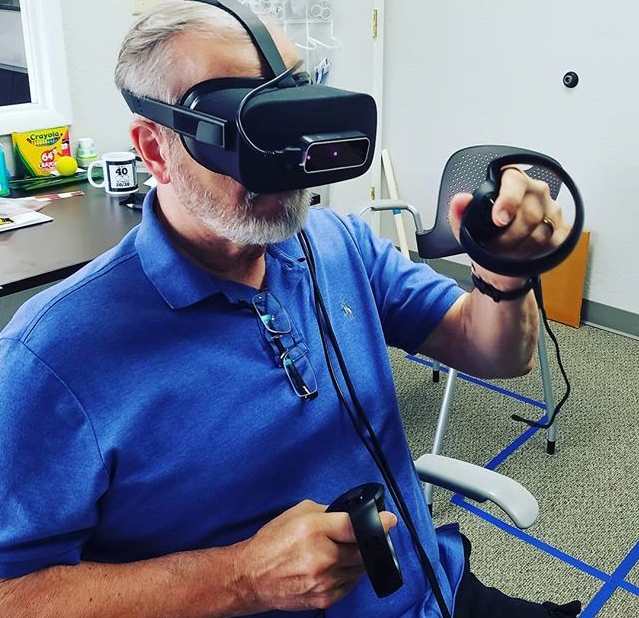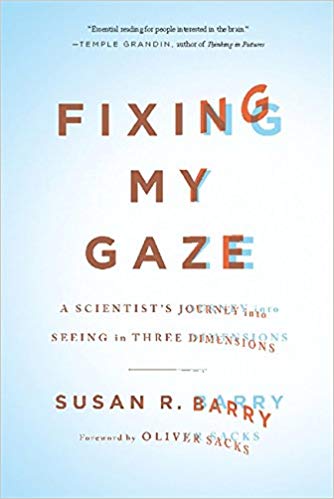Treating Lazy Eye in Adults

It was long thought that treating amblyopia, the medical term for lazy-eye, after the "critical age" of 8-12 years old was not possible. Unfortunately, many optometrists and ophthalmologists still believe, refer to, and share this outdated view. Research, clinical trials, and well-documented patient cases, now show that amblyopia can be treated well into adult hood.
If you have lazy eye and are older than 17, don’t let your age be a deterrent. Even adults with lazy eye can often achieve better vision with treatment, so it’s worth talking to your doctor about options. Vision therapy has been shown to greatly improve the visual skills of the lazy eye by re-training the visual system. Recent studies have shown that the neural pathways of the brain can be enhanced at any age—this means that a lazy eye can actually be treated at any age, even into adulthood.
Brain Plasticity
In an excerpt from Stereopsis and amblyopia: A mini-review. Levi et al explain, "Brain plasticity is known to peak during a critical period in early childhood and to decrease thereafter (Bavelier et al., 2010; Movshon & Van Sluyters, 1981; Wiesel, 1982)." They go on to explain that this highlights the effectiveness of early intervention but the assumption that plasticity ends after a critical period has been detrimental to patient care.
Levi et al lament, "Amblyopic patients over the age of seven are often told that they will never be able to recover visual acuity or stereovision because their visual system is beyond the critical period for binocular vision. Young brains are certainly much more plastic than older ones, yet the last 15 years have shown that significant plasticity can still be induced beyond the critical period if appropriate input is provided." They share multiple references supporting this claim: Baroncelli, Maffei, & Sale, 2011; Bavelier et al., 2010; Hess, Thompson, & Baker, 2014; Levi, 2012; Levi & Li, 2009; Levi & Polat, 1996; Morishita & Hensch, 2008; Wong, 2012.
Though it can be more difficult to treat adults, there is evidence that improvements in acuity, depth perception, and vergence ability are all possible through vision therapy, eye surgery, and visual perceptual training. Amblyopia is treated through a combination of lenses and active vision therapy including virtual reality programs.
Stereo Sue
Dubbed “Stereo Sue” by neurologist Oliver Sacks in a New Yorker article by that name, Dr. Susan Barry is the author of the book Fixing My Gaze which describes her astonishing experience of gaining 3D stereovision after a lifetime of seeing in only two dimensions.

Dr. Barry was cross-eyed from early infancy and had three surgeries as a child that, according to her, "made my eyes look more or less straight." Dr. Barry did not develop stereovision until age 48 when she underwent optometric vision therapy under the guidance of a developmental optometrist. As a neurobiologist, Dr. Barry is in a unique position to tell her life story because she can, and does, give scientific explanations for why her eyes and brain could not produce 3-D images, and how she fixed that problem.
Vision Therapy for Adults with Lazy Eye
Recent Research
Recent research (Ziak at al) has shown improved visual acuity as well as improved stereo acuity at statistically significant levels in amblyopic patients aged 17-69 using virtual reality vision therapy technology. Another recent study (Ho et al, 2019) also showed improved visual acuity and stereo acuity in amblyopic and strabismic patients aged 3-69 using virtual reality vision therapy technology who were previously unsuccessful in traditional patching or occlusion therapy.
These studies are supported by another study by Vedamurthy et al where adult patients aged 19-56 with stereo-impairments (such as refractive amblyopia, alternating exotropia, and esotropia) trained weekly in a dichoptic virtual reality environment and the participants made measurable improvements in areas like visual acuity, reduced suppression, and stereo acuity. These studies all featured success using vision therapy activities in adult patient populations with varying diagnoses.
References
-
Stereo Sue Barry: www.stereosue.com/who-is-stereo-sue/
-
Stereopsis and amblyopia: A mini-review. Levi DM, Knill DC, Bavelier D. Vision Res. 2015 Sep;114:17-30. Accessed: www.ncbi.nlm.nih.gov/pubmed/25637854
-
Bavelier, D., Levi, D. M., Li, R. W., Dan, Y., & Hensch, T. K. (2010). Removing brakes on adult brain plasticity: From molecular to behavioral interventions. The Journal of Neuroscience, 30(45), 14964–14971. Accessed: https://www.ncbi.nlm.nih.gov/pmc/articles/PMC2992973/
-
Baroncelli, L., Maffei, L., & Sale, A. (2011). New perspectives in amblyopia therapy on adults: A critical role for the excitatory/inhibitory balance. Frontiers in Cellular Neuroscience, 5, 25. Accessed: https://www.frontiersin.org/articles/10.3389/fncel.2011.00025/full
-
Hess, R. F., Thompson, B., & Baker, D. H. (2014). Binocular vision in amblyopia: Structure, suppression and plasticity. Ophthalmic and Physiological Optics, 34(2), 146–162. Accessed: https://www.ncbi.nlm.nih.gov/pubmed/24588532
-
Levi, D. M. (2012). Prentice award lecture 2011: Removing the brakes on plasticity in the amblyopic brain. Optometry and Vision Science, 89(6), 827–838. Accessed: https://www.ncbi.nlm.nih.gov/pmc/articles/PMC3369432/
-
Levi, D. M., & Li, R. W. (2009). Perceptual learning as a potential treatment for amblyopia: A mini-review. Vision Research, 49(21), 2535–2549. Accessed: https://www.ncbi.nlm.nih.gov/pubmed/19250947
-
Levi, D. M., & Polat, U. (1996). Neural plasticity in adults with amblyopia. Proceedings of the National Academy of Sciences of the United States of America, 93(13), 6830–6834. Accessed: https://www.ncbi.nlm.nih.gov/pmc/articles/PMC39113/
-
Morishita, H., & Hensch, T. K. (2008). Critical period revisited: Impact on vision. Current Opinion in Neurobiology, 18(1), 101–107. Accessed: https://www.ncbi.nlm.nih.gov/pubmed/18534841
-
Movshon, J. A., & Van Sluyters, R. C. (1981). Visual neural development. Annual Review of Psychology, 32, 477–522. Accessed: https://www.annualreviews.org/doi/abs/10.1146/annurev.ps.32.020181.002401
-
Wiesel, T. (1982). Postnatal development of the visual cortex and the influence of environment. Nature, 299, 583–591. Accessed: https://www.nature.com/articles/299583a0
-
Wong, A. M. (2012). New concepts concerning the neural mechanisms of amblyopia and their clinical implications. Canadian Journal of Ophthalmology, 47, 399–409. Accessed: https://www.ncbi.nlm.nih.gov/pubmed/23036539
-
Žiak P, et al. (2017). Amblyopia treatment of adults with dichoptic training using the virtual reality oculus rift head mounted display: preliminary results. Accessed: https://www.ncbi.nlm.nih.gov/pubmed/28659140
-
Ho et al. (2019) Binocular treatment for amblyopia in adults and children with low-pass filtering when occlusion therapy fails. ARVO 2019 Poster Session. https://www.seevividly.com/downloads/Ho_BV_Treatment_When_Occlusion_Fails_ARVO_2019.pdf
- Vedamurthy I et al. (2016) Recovering stereo vision by squashing virtual bugs in a virtual reality environment. Phil. Trans. R. Soc. B 371: 20150264.http://dx.doi.org/10.1098/rstb.2015.0264
The Vision Wiki
- Lazy Eye
- History of Lazy Eye
- Convergence Disorders
- Convergence Insufficiency
- Exophoria
- Esophoria
- Medical Terms
- Accommodation Disorders
- Accommodative Esotropia
- Accommodative Insufficiency
- Amblyopia
- Lazy Eye in Adults
- Strabismic Amblyopia
- Refractive Amblyopia
- Anisometropia
- Critical Period
- Strabismus
- Anomalous Retinal Correspondence
- Transient Strabismus
- Exotropia
- Esotropia
- Hypotropia
- Hypertropia
- Eye Problems
- Binocular Vision
- Physiology of Vision
- Lazy Eye Treatments
- Reading
- Fields of Study
- Research
- Glaucoma
- Virtual Reality
- Organizations
